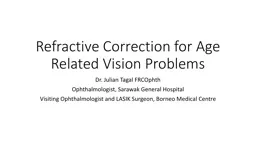

Dr Julian Tagal FRCOphth Ophthalmologist Sarawak General Hospital Visiting Ophthalmologist and LASIK Surgeon Borneo Medical Centre Financial Disclosure NONE Aging It Happens to Everyone ID: 784898
Download The PPT/PDF document "Refractive Correction for Age Related Vi..." is the property of its rightful owner. Permission is granted to download and print the materials on this web site for personal, non-commercial use only, and to display it on your personal computer provided you do not modify the materials and that you retain all copyright notices contained in the materials. By downloading content from our website, you accept the terms of this agreement.
Slide1
Refractive Correction for Age Related Vision Problems
Dr. Julian
Tagal
FRCOphth
Ophthalmologist, Sarawak General Hospital
Visiting
Ophthalmologist and LASIK
Surgeon, Borneo
Medical Centre
Slide2Financial Disclosure
NONE
Slide3Aging – It Happens to Everyone
Slide4We can age badly..
Slide5Or we can age gracefully..
Slide6The choice is often up to us..
Slide7We are unable to disrupt aging…
Slide8But what we can do, is learn how to age well…
Slide9And that means, understanding your body..
Slide10It’s very important to take care of your eyesight as you age..
Slide11Slide12Social
Relationships
Environment
Emotional Wellbeing
Work
Health
Personal Safety
Financial Wellbeing
Belonging
Slide13So what does refraction have to do with our
quality of life?
Refraction is the process by which the eye focuses light to form clear images
Slide14Contents
1. What is Refraction?
2. Functional Ocular Anatomy and how does it relate to refraction
3. Refractive Disorders
4. Non Surgical Options for Refractive Correction
5. Surgical Options for Refractive Correction
Slide15What is Refraction
First described by Persian
mathematician and physicist, Ibn Sahl
in AD 984 in 'Burning Mirrors and Lenses'
Slide16What is Refraction?
Physics of refraction describe the passage that light takes as it moves between media of different density
Slide17Functional Ocular Anatomy
f
1st Refracting Interface
2
nd
Refracting Interface
Slide18How Does Anatomy Relate to refraction?
Slide19How does Anatomy Relate to Refraction?
Slide20How does Anatomy Relate to Refraction?
The CORNEA and LENS are the refracting surfaces
Help to focus light on to the
RETINA
to produce clear images
The process of ACCOMMODATION allows objects at near distances to remain in focus
Slide21Refractive Disorders
Refractive disorders are disorders of focus
1. Myopia (Short Sightedness)
2. Astigmatism
3. Presbyopia
4. Cataracts
Slide22Refractive Disorders - Myopia
Commonly known as 'short
sightedness’;
Occurs when the CORNEA is too steep; or the EYEBALL is too long
As a consequence, light from distance is focused not on the fovea, but rather in front of it
This results in a blurred image
Slide23Refractive Disorders - Myopia
As a consequence, myopic people are only able to view near items clearly
Slide24Refractive Disorders – Myopia
Most Common Refractive Disorder
In the Asian context, suggested to be highest amongst urban
chinese
, prevalence suggested to be as high as 39% amongst 40-79 year olds
1
Wong TY, Foster PJ,
Hee
J, Ng TP,
Tielsch
JM, Chew SJ
et al
. Prevalence and risk factors for refractive errors in adult Chinese in Singapore. Invest
Ophthalmol
Vis
Sci
2000; 41: 2486–2494. |
PubMed
|
ISI
|
ChemPort
|
Slide25Refractive Disorders - Astigmatism
Stems from an abnormally curved CORNEA
Causes poor focus of light on the retina
Slide26Refractive Disorders - Astigmatism
As a consequence, patients with significant astigmatism have blurred vision at all distances
Slide27Refractive Disorders - Presbyopia
Also known as 'age related diffficulty in reading'
Caused by failure of the natural lens to accommodate
May result in eyestrain, and discomfort during near tasks
Occurs later in myopic people
Slide28Refractive Disorders - Cataract
Slide29Refractive Disorders - Cataract
Slide30Refractive Disorders
Different Refractive Disorders Can Exist in the same eye
Methods of correction should ideally aim to correct everything simultaneously
Slide31Non Surgical Correction
1. Leaving it alone
2. Spectacles
3. Contact Lenses
Slide32Non Surgical Correction - Spectacles
Available widely and affordable/little maintenance compared to contact lenses
Available in
monofocal
options (Distance/Near or even Task specific)
Available in multifocal/
varifocal
options correcting everything
Unable to correct errors due to cataracts
May be unnecessarily heavy; hinders sports and outdoor activities
Slide33Non Surgical Correction - Spectacles
Slide34Non Surgical Correction – Contact Lenses
Available in
Monofocal
or Multifocal options
Allows correction of myopia/hyperopia/astigmatism and presbyopia simultaneously
Requires care and motivation in order to use safely
More expensive and requires more maintenance compared to spectacles
Unable to correct errors due to cataracts
Slide35Surgical Correction
1. LASIK
2. Intraocular Lenses
Slide36Surgical Correction - LASIK
Laser In-Situ
Keratomileusis
Surgical Reshaping of the cornea to correct refractive errors
Able to correct
significant Myopia/Astigmatism/Presbyopia
Unable to correct errors due to cataract
Advantages – Glasses/Contact Lens Free; extremely safe, quick procedure
Slide37Surgical Correction - LASIK
In myopia, the curve of the cornea is often too STEEP or the eyeball is too LONG
In astigmatism, the curve of the cornea is UNEVEN
LASIK is able to correct these errors simultaneously
Slide38Surgical Correction - LASIK
Slide39Surgical Correction – Intraocular Lenses
Preferred choice to LASIK when a person has cataract (in addition to other refractive errors)
Monofocal
or Multifocal lenses
Monofocal
lenses usually correct for distance vision, requiring reading glasses for near tasks
Multifocal lenses allow for clear near and intermediate
vision in addition to distance vision
Slide40Surgical Correction – Cataract Surgery and Intraocular Lenses
Monofocal
IOL
Multifocal IOL
Slide41Surgical Correction – Cataract Surgery and Intraocular Lenses
Slide42Surgical Correction – Cataract Surgery and Intraocular Lenses
Results are often excellent and well tolerated as long as care is taken to select appropriate patients
Many options in the market
Various options grant varying degrees of spectacle/CL freedom at different distances and lighting
Slide43Surgical Correction – Cataract Surgery and Intraocular Lenses
Slide44Conclusion
Refractive Disorders (with rare exceptions) are easily manageable
Surgical Options are widely available, safe and reliable
Excellent investment in advancing
age, because all we want in our older years is -
Slide45Conclusion
Slide46Thank You.